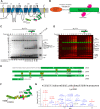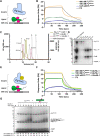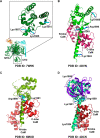The C-Terminal of NaV1.7 Is Ubiquitinated by NEDD4L
- PMID: 38144259
- PMCID: PMC10739247
- DOI: 10.1021/acsbiomedchemau.3c00031
The C-Terminal of NaV1.7 Is Ubiquitinated by NEDD4L
Abstract
NaV1.7, the neuronal voltage-gated sodium channel isoform, plays an important role in the human body's ability to feel pain. Mutations within NaV1.7 have been linked to pain-related syndromes, such as insensitivity to pain. To date, the regulation and internalization mechanisms of the NaV1.7 channel are not well known at a biochemical level. In this study, we perform biochemical and biophysical analyses that establish that the HECT-type E3 ligase, NEDD4L, ubiquitinates the cytoplasmic C-terminal (CT) region of NaV1.7. Through in vitro ubiquitination and mass spectrometry experiments, we identify, for the first time, the lysine residues of NaV1.7 within the CT region that get ubiquitinated. Furthermore, binding studies with an NEDD4L E3 ligase modulator (ubiquitin variant) highlight the dynamic partnership between NEDD4L and NaV1.7. These investigations provide a framework for understanding how NEDD4L-dependent regulation of the channel can influence the NaV1.7 function.
© 2023 The Authors. Published by American Chemical Society.
Conflict of interest statement
The authors declare no competing financial interest.
Figures




References
-
- Goldin A. L.; Barchi R. L.; Caldwell J. H.; Hofmann F.; Howe J. R.; Hunter J. C.; Kallen R. G.; Mandel G.; Meisler M. H.; Netter Y. B.; Noda M.; Tamkun M. M.; Waxman S. G.; Wood J. N.; Catterall W. A. Nomenclature of voltage-gated sodium channels. Neuron 2000, 28, 365–368. 10.1016/S0896-6273(00)00116-1. - DOI - PubMed
Grants and funding
LinkOut - more resources
Full Text Sources

